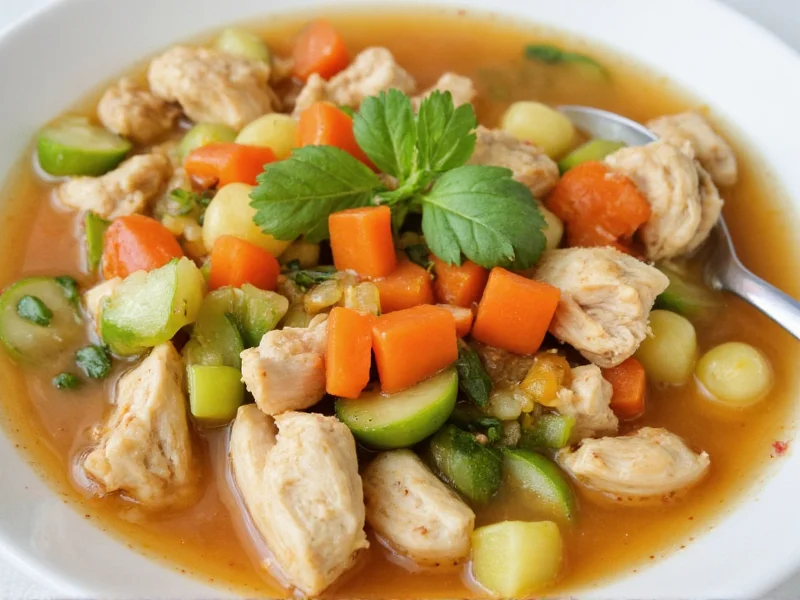Creating the perfect chicken veggie soup requires understanding the balance between protein, vegetables, and broth. This versatile dish serves as both comfort food and nutritional powerhouse when prepared with quality ingredients. Unlike store-bought versions that often contain excessive sodium and preservatives, homemade chicken vegetable soup allows complete control over ingredients and nutritional content.
The Essential Components of Quality Chicken Veggie Soup
Professional chefs and nutritionists agree that exceptional chicken vegetable soup starts with three foundational elements: quality protein source, fresh vegetables, and a rich broth base. For optimal flavor and nutrition, use bone-in chicken pieces which release collagen during cooking, creating a naturally thickened, nutrient-dense broth. The vegetables should represent multiple colors for varied phytonutrients—orange carrots for beta-carotene, green kale for vitamins K and C, and red bell peppers for additional vitamin C.
Step-by-Step Preparation Guide
Follow this professional method for restaurant-quality chicken veggie soup at home:
- Build flavor foundation: Sauté onions, celery, and carrots in olive oil until softened (5-7 minutes)
- Add protein: Brown chicken thighs or breasts on both sides (do not fully cook)
- Create broth base: Add 6 cups low-sodium chicken broth, garlic, and herbs (thyme, bay leaf)
- Simmer protein: Cook chicken partially covered for 20 minutes until nearly tender
- Add vegetables: Incorporate diced potatoes, green beans, and zucchini
- Final simmer: Cook additional 15-20 minutes until vegetables reach desired tenderness
- Finish: Stir in fresh spinach or kale and lemon juice just before serving
Nutritional Benefits of Homemade Chicken Vegetable Soup
Unlike canned alternatives, homemade chicken veggie soup delivers significant health advantages. The combination of lean protein and fiber-rich vegetables creates a satiating meal that supports weight management. Bone broth preparation releases collagen and gelatin, which research suggests may improve joint health and gut integrity. The vegetable variety provides essential vitamins and minerals while keeping the glycemic load low.
| Nutrient | Per Serving (1.5 cups) | Daily Value % |
|---|---|---|
| Calories | 245 | 12% |
| Protein | 18g | 36% |
| Fiber | 5g | 20% |
| Vitamin A | 120% | 120% |
| Vitamin C | 45% | 45% |
Variations for Dietary Needs
Adapt this basic chicken vegetable soup recipe for specific dietary requirements:
- Gluten-free chicken vegetable soup: Ensure broth is certified gluten-free and avoid flour-based thickeners
- Low-sodium chicken soup: Use homemade broth or low-sodium commercial varieties and enhance flavor with herbs instead of salt
- Keto-friendly version: Increase healthy fats with avocado oil, add more above-ground vegetables, and reduce starchy components
- Instant Pot chicken veggie soup: Pressure cook for 10 minutes followed by natural release for faster preparation
Avoiding Common Preparation Mistakes
Even experienced cooks make these frequent errors when preparing chicken vegetable soup:
- Overcooking vegetables: Add delicate vegetables like zucchini and spinach during the final 10-15 minutes to maintain texture and nutrients
- Using only chicken breast: Incorporate some bone-in pieces for richer flavor and collagen
- Skipping the bloom step: Sautéing vegetables before adding liquid develops deeper flavor through the Maillard reaction
- Underseasoning: Season in layers—when sautéing vegetables, after adding broth, and just before serving
Storage and Reheating Best Practices
Proper storage maintains both safety and quality of your homemade chicken veggie soup:
- Cool soup completely within 2 hours of cooking
- Store in airtight containers for up to 4 days in the refrigerator
- Freeze in portion-sized containers for up to 3 months
- Reheat gently on stove over medium-low heat to preserve vegetable texture
- Add fresh herbs and a splash of lemon juice after reheating for bright flavor
Seasonal Adaptations for Year-Round Enjoyment
Adjust your chicken vegetable soup ingredients based on seasonal availability for optimal flavor and nutrition:
- Spring: Incorporate fresh peas, asparagus, and baby spinach
- Summer: Add zucchini, yellow squash, and fresh tomatoes
- Fall: Include butternut squash, sweet potatoes, and kale
- Winter: Use hearty root vegetables like parsnips, turnips, and cabbage
Frequently Asked Questions
How can I make chicken vegetable soup without鸡汤 base?
Create a flavorful broth by simmering chicken bones with vegetables and herbs for 2-3 hours. Add 1 tablespoon apple cider vinegar to help extract minerals from bones. Strain the broth before adding additional vegetables for your soup.
What vegetables hold up best in chicken soup for meal prep?
Root vegetables like carrots, parsnips, and turnips maintain their texture during storage. Add delicate vegetables like zucchini and spinach when reheating individual portions to preserve their texture and nutritional value.
Can chicken veggie soup help with cold recovery?
Yes, the steam from hot soup helps clear nasal passages, while the hydration and electrolytes support recovery. Chicken contains cysteine which may help thin mucus, and the vegetables provide immune-supporting vitamins. Keep sodium levels moderate for optimal hydration benefits.
How do I prevent chicken from becoming dry in soup?
Remove chicken from the broth once it reaches 165°F (74°C), let it rest, then shred and return to the soup just before serving. Alternatively, use thighs which contain more fat and stay moist during longer cooking times compared to breast meat.
What's the best way to add depth of flavor to vegetarian chicken-style soup?
For vegetarian versions, create umami depth with dried mushrooms, nutritional yeast, miso paste, and smoked paprika. Sauté onions until deeply caramelized and add a splash of soy sauce or tamari for savory notes that mimic chicken broth complexity.











 浙公网安备
33010002000092号
浙公网安备
33010002000092号 浙B2-20120091-4
浙B2-20120091-4